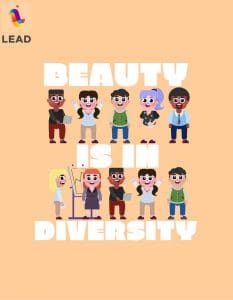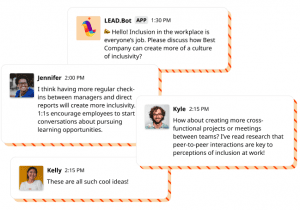For the past years, workplaces underwent significant reformation processes: structures changed, hierarchies became open spaces, and company values redefined. More than hard work, integrity, and grit—organizations are now propelled to incorporate Diversity, Equity, and Inclusion (DE&I) in every aspect of the modern workplace dynamics.
A diverse workforce opens a big room full of ideas and perspectives from people with different cultural and ethnic backgrounds. An ongoing discussion about DE&I propels understanding and increases employee engagement. Empowering these ideas to be heard and recognized fell unto the responsibility of HR leaders who can foster DE&I programs that pioneer discussions about internal equity and equality.
However, creating DE&I initiatives is easier said than done. It will take a collective unlearning process of unconscious biases to build inclusion in your workplace. Implementing well-rounded DE&I training, programs, and information brigades that encapsulate inclusive behaviors requires intensive research and planning.
How to start organizing a DE&I strategy?
Diversity, equity, and inclusion start within the organization. Assessing what is lacking in the workplace by comparing the best DE&I practices of other organizations to the current strategies of your organization is an excellent start on the areas that you need to improve.
After identifying the areas that need improvements, leaders should test the waters first. HR leaders can tap managers to disseminate policies about equity and inclusion, or share news articles and video links with their subordinates. Below are some key topics essential to creating an inclusive workspace for everyone.
1. Understand the differences between diversity, equity, and inclusivity.
 Diversity, in the simplest sense, can be defined as the considerable differences between groups of people, ideologies, or ages, that set people apart. Beneath what’s heard and seen, diversity also refers to the way these differences are recognized, accepted, and valued in a workplace.
Diversity, in the simplest sense, can be defined as the considerable differences between groups of people, ideologies, or ages, that set people apart. Beneath what’s heard and seen, diversity also refers to the way these differences are recognized, accepted, and valued in a workplace.
Equity is the framework of an organization that provides fair access to employees—despite differences—to opportunities, career advancements, and policy representations. A fair work environment for all creates a balanced playing field where everyone is encouraged to join and play their part. Empowering qualified women and members of the LGBTQ+ community to be represented in senior management positions is a way to include equity in your work processes.
On the other hand, inclusivity is the belongingness that employees feel in their workplaces. Inclusiveness is how employees personally resonate with their job and the workspace that they belong to. Inclusivity is where DE&I programs should work holistically since it is the core of collective empathy and camaraderie.
Diversity, equity, and inclusion are all interconnected, and understanding their differences will make your DE&I initiatives more targeted based on the needs of your workplace. Moreover, DE&I programs can boost employee experience, leading to an increase in productivity. DE&I effort just goes to say that if you invest in your employees, the advantages that will return to you will be tenfold.
2. How to recognize microaggressions?
A systemic problem is a byproduct of accumulated microaggressions. In workplaces, microaggressions may come in different forms like verbal and nonverbal cues, hostility and derogatory language, and unsolicited remarks attacking someone who is usually from a different race or background.
Is interrupting a woman in the middle of her report alright? Is it okay to assume a coworker’s sexual orientation because they dress a certain way? Intentional or not, knowing how to stand up or mediate between these remarks is necessary for creating a safe workplace.
Training employees about how to recognize these aggressions is a way to become more aware of the implications that these negative behaviors cause. Showing the entire thought process between microaggressions. Teaching people the relevance of pronouns as identifiers. Tones and wordings come across differently for different individuals.
Learning about sensitivity can broaden the perspective of the majority on how much their action affects others. Additionally, knowledge about sensitivity encourages people to check on their coworkers, and reflect on their responses whenever marginalized groups in the company are being treated that way.
3. Normalizing bystander intervention.
Humanity is rooted in the moral obligation that people have to each other, and the world will be in chaos without it. Similarly, humanity plays an essential role in the workplace.
“If it does not concern me, why should I care?”. There are many reasons why bystanders remain silent even when an injustice is happening right in front of them. Others fear isolation, while some don’t want to get caught up in the potential risk of career instability.
Fostering the right balance of individualism and taking one for the team is a way to establish camaraderie and empathy towards one another. Building trust and bonds within the workplace are how you make people care. If employees have a sense of collective responsibility to each other, you can count on anyone to stand up with coworkers. Collective responsibility also applies to those who are often subjected to aggressions and mistreatments against DE&I policies.
4. Building cultural awareness.

A work culture that respects ALL cultures can become a reality through DE&I programs. Building a more inclusive culture starts with recognizing that not everyone practices the same belief, holidays, and traditions. DE&I initiatives like personalizing virtual bulletin boards allow employees to communicate with colleagues during special occasions appropriately.
HR leaders can also make the DE&I initiative fun by creating communication plans showcasing differences between employees, which can be a blog getting to know a culture through an employee, a “social-media-takeover” where someone can take pictures or produce a video about their holiday traditions, or how they cook breakfast from where employees are working remotely as of the moment.
Aside from building awareness, these kinds of programs also target the sense of belongingness of an employee at work—hitting the entire values of DE&I at the same time. On top of that, an inclusive workplace can lead to higher employee retention. So, if employees feel valued for who they are—culture and all—they are more likely to stay.
5. Anti-harassment in the workplace.
Work is one of the places where harassment and discrimination happen predominantly, which is why one should also emphasize how the initiative can address the possible harassment that might take place when creating DE&I programs. Creating a code of conduct would be a good start.
A safe and secure work environment should accompany inclusivity and diversity pieces of training to ensure that everyone is safe from potential risks. Offering safety training and opening emergency helplines that are accessible at any time of the day can be helpful for emergencies in the workplace.
As much as possible, DE&I programs should be able to prevent harassment from materializing. However, if worse comes to worst, these initiatives must be designed proactively—with plans ready to be implemented to help employees respond and heal from the trauma they experienced.
DE&I is at the center of the future of work.
Although it is impossible to make a systemic reset overnight, leaders can always take little steps every day to create and implement data-driven DE&I programs. A simple DE&I program can start with ERG groups.
An employee resource group (ERG) is a voluntary, employee-led diversity and inclusion initiative that is formally supported by an organization. ERGs generally are organized on the basis of common identities, interests, or backgrounds with the goal of supporting employees by providing opportunities to network and create a more inclusive workplace. Organizations use many naming conventions to refer to ERGs, such as business resource groups, affinity groups, inclusion resource groups or network groups.
Next, is to provide the ERG with some budget to create their own events, such as coffee- meetups, or group discussions. One interesting ERG program we’ve seen is to use LEAD.bot to facilitate discussions among ERG members.
 With LEAD.bot’s DE&I template, it is easy to create not just ERG-based events but also company-wide discussions around diversity, equity, and inclusion. If you are a LEAD.bot admin or user and would love to learn more about how to run those programs, you can always reach out to our customer success team at cs@lead.app
With LEAD.bot’s DE&I template, it is easy to create not just ERG-based events but also company-wide discussions around diversity, equity, and inclusion. If you are a LEAD.bot admin or user and would love to learn more about how to run those programs, you can always reach out to our customer success team at cs@lead.app
LEAD by example and start the conversation NOW.
Whether focused on developing or retaining diverse talent and inclusive culture, DE&I strategies are strongest when they address your specific areas of concern and align with business objectives. To make your DE&I initiatives more impactful, leaders and employees should think and act as one. It is never too late to start the conversation by organizing and inviting employees to #DEI_channel to share and discuss materials based on DE&I efforts. Last but not least, add LEAD.bot to your #DEI_channel in Slack or DEI_team in Microsoft Teams. For the best results, we recommend that companies set communication rules and add the rules as a hyperlink into LEAD.bot’s intro message before starting their DE&I matching programs.
Remember—change doesn’t have to be grand to make an impact. Instead, change with the culmination of positive attitudes and hard work—that makes up for an inclusive workspace. Maximize company culture and employee engagement platforms like LEAD.bot to promote and empower diversity, equity, and inclusion through matching channels. It is how you LEAD by example—by starting from within.









